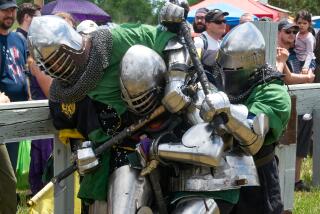Medieval Times’ Red Knight reflects on fun of taking up the sword
- Share via
The Red Knight gallops onto the battlefield astride a chestnut horse. Fifty feet away, the Green Knight squares off against him.
Lances at the ready, the two horsemen charge each other to the blare of trumpets and the cheers from hundreds of lords and ladies (many of them very small lords and ladies).
This could be an English meadow 600 summers ago. Instead, it’s a concrete facsimile of a medieval castle plopped down on a busy street in Buena Park. And the man underneath those crimson robes isn’t really the Red Knight — he’s William Elliot III, 35, who grew up in Orange County and once dreamed of becoming a magician.
CRITICS’ PICKS: What to see, do, taste and more this weekend
“I’ve always been a performer and a ham,” the Medieval Times jouster said. “I’ve always wanted to be in the limelight. It’s now a daily thing.”
But how do you become a “show knight,” exactly? And not just any knight, but the “truest son of mighty Castilla, Baron Ruiz de Roche One,” as the company’s website says of the Red Knight. “Set him at liberty, and he’ll paralyze the enemy!”
Before he was even a lowly squire, Elliot started out at a Medieval Times gift store, selling tickets to the show, swords and shields. At the store, he learned he could dream bigger. He could be a knight.
Although he didn’t have any experience with medieval weaponry or fighting techniques, he did know how to ride a horse. Six months after joining the company, he was “knighted.”
Ten years later — and quite a few years older than most of his fellow knights — Elliot is still at it.
The pay certainly isn’t the draw — $12.50 an hour to start, topping out at about $21 an hour. Elliot says the best part of the job is the camaraderie with his fellow jousters, and the response he gets from the crowd at the 90-minute show, which he performs up to three times a day.
ON LOCATION: Where the cameras roll
“When you go out there and see the little kids, their faces light up,” he said. “There’s just so much crap going on in the world and this gives kids something to dream about.”
Elliot looks the part, with a slim, muscular physique and brown hair that flows to his shoulders. His chin and upper lip are brushed with scruff. Tattoos decorate his arms, including a cross beneath his right bicep with a quotation from Proverbs: “Trust in the Lord with all your heart and lean not on your own understanding; in all ways submit to him, and he will make your paths straight.”
But one thing about his looks doesn’t fit the classic profile: At 5 feet 7, Elliot is the runt of the Buena Park castle’s knights. When he was at the gift store, he was discouraged from trying to be a knight because of his height. Elliot persisted, saying what he lacked in stature he made up in attitude and confidence:
“If you think, ‘I’m not good enough, I’m not strong enough,’ you never will be good enough or strong enough.”
Magic beginnings
Elliot grew up the son of a preacher in Santa Ana. Before he stumbled into his knightly career, he tried to make it as a magician. He moved to Las Vegas, performing table tricks at restaurants. He didn’t see much of a future.
“To get into magic and make it a career, you have to hit the pavement,” Elliot said. “It’s difficult to make a living doing it.”
PHOTOS: Celebrities by The Times
At 25 he was back in Orange County, working at a Medieval Times gift store in Irvine (now closed). That’s where the jousting life began.
The path to knighthood begins as a squire, a job that entails caring for the show’s horses and keeping the knights’ weapons and armor in good repair. Squires who demonstrate a solid work ethic and reliability are accepted into the knight apprentice program — provided they have “the look.” A sturdy physique is important, and a healthy mane of hair is a big plus.
“There is a look we’re looking for,” said Celeste Lanuza, senior vice president of marketing and sales at Medieval Times, based in Dallas. “We’re looking for somebody who’s been athletic. They have to have crowd appeal.”
Lanuza said the company employs 134 knights and 74 squires at its nine “castles” in the U.S. and Canada, and most of them had little or no horseback riding experience, let alone a working knowledge of medieval combat techniques. Knights are typically 18 to 25, and most spend about five years at the company before moving on.
Medieval Times got its start on the Spanish island of Majorca in 1973, and made its first foray into the U.S. market in 1983. The Buena Park castle opened in 1986 and quickly became its top destination, drawing about 450,000 guests last year and staging up to 21 tournaments a week.
The show costs about $36 for children and nearly $60 for adults, and includes a dinner served without utensils. The show features a series of jousts, followed by dismounted knights engaging in hand-to-hand combat with swords, axes and other weapons.
As the assistant head knight, Elliot helps manage the 19 knights on staff and choreographs the show. Before each performance Elliot writes down the names of each knight, assigns each a color and (spoiler alert!) designates who will win and who will lose.
Typically the younger and less experienced knights lose the first few rounds, setting up the climactic battles between the more experienced combatants.
Injuries do occur. Elliot has broken a thumb, dislocated fingers and even had to get stitches on his forehead after a dismount from a horse ended with his face smashing into the brick wall.
“Blessed by God,” he said, “is how I haven’t been seriously injured.”
Close bonds
After work many of the knights hang out together. Elliot rents a room in a house that is, in a way, a medieval castle of its own — with the man who plays the chancellor in the show, a fellow knight and an apprentice knight.
On Christmas any knight without a nearby home or relatives is invited to Elliot’s family home to spend the holiday with him, his two brothers, father and mother.
“Calling them a second family wouldn’t do it justice,” said knight Conor McLandrich. “You put your life in the other person’s hands.”
McLandrich, 25, is an intimidating presence. The 6-footer weighs 210 pounds and can bench-press more than his weight. He’s been a knight for almost three years, and it took him about six months to train for the position.
As an apprentice knight McLandrich learned how to ride a horse, first without stirrups and reins, under Elliot’s tutelage. He was also taught to fight with the weapons, learning choreographed routines.
“We make it look really easy, but it’s not as easy as it looks,” McLandrich said. “It still blows my mind that I’m doing this.”
McLandrich plans on working up the ladder and one day becoming a head knight. He added that Elliot was a “fantastic” teacher because he “walked the line between boss and colleague.” He developed a close relationship with Elliot, even asking him to be his best man at his coming wedding.
“I am a coach, I am an older brother, I’m a counselor,” Elliot said. “I’ve done it all for these guys.”
But his age is a factor now. By working out, he hopes to have a few more years. He would like to be promoted to head knight some day, and then stay with the company in some fashion, perhaps in marketing.
“I’m going to do this for as long as I can,” he said. “We’re all grown-up kids here. It’s a fun job.”
Clashing swords
Later in the show the Red Knight prevails in the joust against the Green Knight, knocking him off his horse.
The two unsheathe their swords and continue the fight. The Green Knight succumbs to repeated blows, and then the Red Knight turns his sword against the Red & Yellow Knight, who has vanquished his opponent.
The two clang away as audience members cheer on their champion. Eventually the Red Knight falls. On this evening, the Red & Yellow Knight is the victor.
After 10 years of performing Elliot takes the defeat in stride. (As well he might, seeing as he choreographed his fate.)
“I don’t care if I win,” Elliot said with a smile. “I don’t need the glory anymore.”
More to Read
From the Oscars to the Emmys.
Get the Envelope newsletter for exclusive awards season coverage, behind-the-scenes stories from the Envelope podcast and columnist Glenn Whipp’s must-read analysis.
You may occasionally receive promotional content from the Los Angeles Times.








